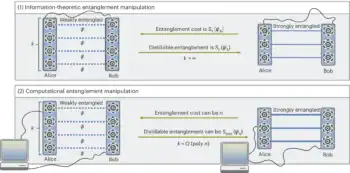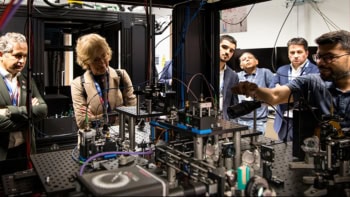
Physicists in Italy have designed a “quantum battery” that they say could be built using today’s solid-state technology. They claim that the device, which would store energy in the excited states of qubits, could charge up very quickly thanks to entanglement and that it could provide power for quantum computers of the future.
This research is part of a push by physicists to study the thermodynamics of very small systems, such as atomic or molecular heat engines and refrigerators. In 2012, Robert Alicki of the University of Gdansk in Poland and Mark Fannes of Leuven University in Belgium investigated how much work could be extracted reversibly from a quantum-mechanical system used to store energy temporarily. They found that by entangling many quantum batteries together they could boost the energy output per battery such that for very large numbers of them the output approached the upper limit imposed by classical thermodynamics.
Other groups have since built on that work, with one led by Kavan Modi at Monash University in Australia last year having found that collective effects can increase the charging rate of quantum batteries (even if the quantum states involved are not entangled). Now, Marco Polini and colleagues at the Italian Institute of Technology (IIT) in Genoa have shown that these theoretical ideas could in fact be realized in practice.
Qubit conversations
The Genoa team proposes housing multiple two-level quantum systems, or qubits, inside a single optical cavity (see figure). Light with a specific wavelength is shone into the cavity – in the form of a laser pulse, for example – where it excites the qubits from their ground to excited states while at the same time entangling them. This arrangement, the researchers calculate, increases the device’s charging power in proportion to the square root of the number of qubits, whereas the charging rate remains flat if qubits are housed in separate optical cavities. As Polini puts it, the use of a common cavity means that “every qubit talks to every other qubit”.
Polini says that their system doesn’t violate any laws of thermodynamics since it merely involves a higher rate of energy flow from source to battery than is possible conventionally, rather than any increase in the total amount of energy. The scheme involves a trade-off between charging power and stored energy, with the balance between the two determined by how strongly photons and qubits couple to one another.
Polini explains that the research, while theoretical, is more practically oriented that previous work. “Historically, the few papers in the literature on quantum batteries come from scientists in the quantum information community, who are more interested in fundamental theorems than in actual solid-state implementations of their ideas,” he says. “We read their papers [on quantum batteries] and saw that this can be done in the lab.”
Prototype in three years
According to Polini, the proposed quantum batteries could use qubits built either from superconductors or from semiconducting quantum dots. He says that they are hoping to build a proof-of-principle quantum battery in conjunction with experimentalists from IIT and three other European institutions – having submitted a grant application to the European Union’s flagship programme on quantum technologies. He reckons that the collaboration could potentially build a battery with up to five qubits within the next three years.
Polini, however, is keen to emphasize that the technology is not designed for powering laptops or other familiar electronic devices. As he notes, the quantum batteries would discharge extremely quickly – on the order of nanoseconds – and would also store exceptionally small amounts of energy. Indeed, he says, the energy stored in a quantum battery is linked to the difference in a qubit’s energy levels amounts to about 0.001 eV, whereas a typical laptop battery stores a few 1024 eV. “These devices will not replace normal batteries,” he says.

Quantized vibrations are essential to photosynthesis, say physicists
Instead, Polini sees the batteries in future powering purely quantum-mechanical devices, such as quantum computers. An array of perhaps a few thousand qubits, he estimates, might be available in “10 or 20 years” from now. The array, he envisages, would operate in a loop, so that each qubit recharges while the computer taps the energy from successive qubits. “Our dream is that you have an integrated circuit based on quantum technologies,” he says. ”Every unit of the circuit would work quantum mechanically, including the battery.”
Noisy challenge
Modi says it’s “really surprising” that the IIT researchers have managed to find “physical architectures that accommodate our toy models”. But, he cautions, they must show that their technology can resist environmental noise. “Most likely we won’t see a quantum battery anytime soon, and it’s not clear how we might use such a battery,” he says. “There is a lot of theory that has to be done before we can do experiments, and some day engineering.”
The battery design is described in Physical Review Letters.



